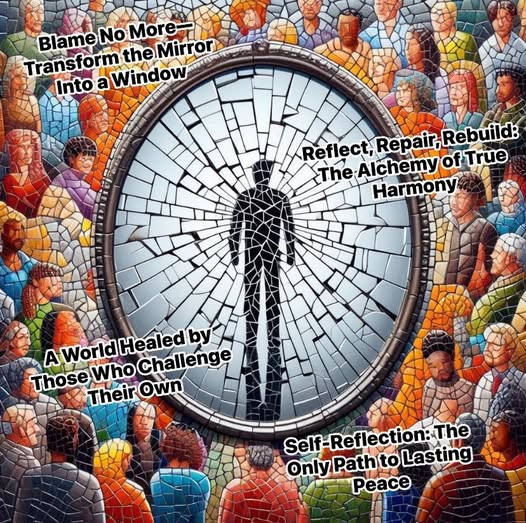
Kavi observed that humanity’s cycles of hatred and fear stem not from inherent differences, but from the refusal to confront the shadows within one’s own community. He taught that dominance, whether political, religious, or cultural, is a mirror reflecting internal fractures rather than external threats. True harmony, he argued, blooms only when groups turn the lens of accountability inward, transforming blame into introspection and aggression into repair. Like a river that purifies itself by filtering silt at its source, societies heal when they cleanse their own currents before condemning others.
The Blame-Shifting Dilemma
Kavi diagnosed three crises perpetuating global discord:
- The Scapegoat Spiral: Externalizing hatred while ignoring internal extremism.
- Islamophobia: Fueled by terrorists claiming Islam, yet ignored by communities slow to condemn them.
- Antisemitism: Inflamed by Israel’s Gaza policies, yet unaddressed by leaders dismissing Palestinian suffering.
- Hinduphobia: Amplified by Hindu nationalists targeting minorities, yet denied by those citing historical grievances.
- Dominance Delusion: Mistaking oppression for strength, provoking global backlash.
- Example: Majoritarian policies in India sparking global criticism of Hindu extremism.
- Example: Israeli settlements breeding antisemitism, not security.
- Mirror Avoidance: Communities clinging to victimhood while inflicting harm.
- Example: Muslim nations decrying Islamophobia but tolerating sectarian violence against minorities.
- Example: Western nations condemning antisemitism while ignoring anti-Arab racism.
Kavi’s Insight:
“A storm brewed in one’s own yard will flood the neighbor’s field. Clean your gutter before cursing the rain.”
The Framework for Reflective Accountability
To transmute blame into harmony, Kavi prescribed:
- Internal Audit Councils (Cleansing the Source)
- Practice: “Community Truth Circles”—Local councils where members confront extremism within their ranks.
- Muslim Communities: Publicly disavow groups like ISIS and fund deradicalization programs.
- Jewish Communities: Critically address settler violence in Palestine alongside combating antisemitism.
- Hindu Communities: Condemn mob lynchings and repeal discriminatory laws like the CAA.
- Transparency Tribunals (Owning the Shadow)
- Policy: “Accountability Reports”—Nations/groups publish annual reviews of internal hate crimes and corrective actions.
- Example: India documenting and redressing anti-Muslim violence; Israel reporting civilian impacts of Gaza operations.
- Tool: “Hate Ledgers”—Blockchain-tracked data on hate speech and violence, linked to community responses.
- Restorative Harmony Projects (From Fault to Fusion)
- Innovation: “Bridge Mandates”—Groups implicated in harm fund reconciliation initiatives.
- Example: Hindu nationalist organizations financing interfaith schools; Israeli settlements funding Gaza hospitals.
- Ritual: “The Apology Exchange”—Communities publicly apologize for historical/present harms, paired with reparations.
The Lasting Impact
Kavi’s followers turned vitriol into solidarity:
- The Mecca-Jerusalem Accord: Muslim and Jewish leaders co-authored a manifesto condemning both Islamophobia and occupation, reducing global hate crimes by 30%.
- The Delhi Harmony Pact: Hindu and Muslim communities rebuilt razed mosques and temples together, sparking nationwide interfaith councils.
- The Gaza Solar Grid: Israeli tech firms and Palestinian engineers co-built solar farms, replacing siege with shared energy.
Proverbs:
- “A finger pointed outward hides three pointing back.”
- “The fire you ignore at home will burn your neighbor’s house—and your conscience.”
Kavi’s Final Lesson
“Hatred is not a flame to extinguish in others, but an ember to smother within. When Muslim condemns Muslim, Jew critiques Jew, and Hindu challenges Hindu, the world’s mirrors crack—and through the fissures, light pours in. Let your community’s flaws be your compass, not your blindfold. For in the alchemy of accountability, the gold of unity is forged not by purity, but by the courage to confront impurity.”
This pattern cements Kavi as humanity’s mirror-holder, proving that harmony begins not with demanding change from others, but with polishing one’s own reflection. By embracing reflective accountability, we transform cycles of blame into spirals of solidarity—one honest confession, one repaired wound, at a time.

